Catwoman, Nightwing & Robin: the current shape of the Batman Family is a sort of amorphous blob
By Graig
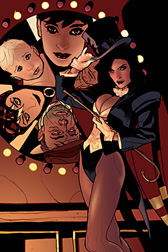 I’m more of a fan of the has-beens and also-rans. Rarely do Superman and Batman excite me as much as, say, Blue Beetle or Firestorm. I can enjoy a good Supes or Bats yarn as much as the next guy or gal, but following their monthly activities hasn’t been a staple of my diet since the mid-‘90’s. For some reason, I’ve also disconnected from their extended families – guilty by association I guess – not routinely picking up Supergirl, Robin or any of the other titles in equally as long.
I’m more of a fan of the has-beens and also-rans. Rarely do Superman and Batman excite me as much as, say, Blue Beetle or Firestorm. I can enjoy a good Supes or Bats yarn as much as the next guy or gal, but following their monthly activities hasn’t been a staple of my diet since the mid-‘90’s. For some reason, I’ve also disconnected from their extended families – guilty by association I guess – not routinely picking up Supergirl, Robin or any of the other titles in equally as long.
Perhaps it’s a lack of threat, a lack of chance, a lack of change that keeps me away. The Flash or Aquaman are routinely put through the wringer, and often times some massive changes happen, but with the big icons and their little sub-universes of
Since the Infinite Crisis, “One Year Later”, now officially six months old, has been about shaking things up, changing the status quo. If anything it’s brought some exciting talent on board the world’s finest’s books, but since the peripherals aren’t getting the same star treatment, how are they holding up, and how accessible are they?
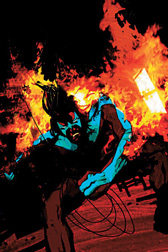 New readers pouncing (sorry) onto Catwoman #58 will find themselves a little lost, as Selena Kyle now has a new name and a child (but still looks fine in a leather catsuit). The problem she’s dealing with at hand is a never-ran criminal named Angle Man who has deduced her new identity and location and is eager to reveal it to the world at large in the name of revenge. Catwoman deals with it in an unexpected way, by calling in Zatanna, who in the past had stolen her memories and now is asked to do the same. Meanwhile, an old crime of Selena’s is causing Holly Robinson (a new Catwoman?) some headaches. Writer Will Pfeifer has multiple balls in the air, and he skilfully juggles them, creating interesting character and plot turns, fitted underneath on-point dialogue and a general sense of knows-what-he’s-doing-ness. The art by David and Alvaro Lopez is clean but slightly generic, yet serving the story at every turn. They do the job well without bringing distractions or much else of interest to the table. Adam Hughes cover, meanwhile, brings plenty of distraction… but where are Zatanna’s fishnets?
New readers pouncing (sorry) onto Catwoman #58 will find themselves a little lost, as Selena Kyle now has a new name and a child (but still looks fine in a leather catsuit). The problem she’s dealing with at hand is a never-ran criminal named Angle Man who has deduced her new identity and location and is eager to reveal it to the world at large in the name of revenge. Catwoman deals with it in an unexpected way, by calling in Zatanna, who in the past had stolen her memories and now is asked to do the same. Meanwhile, an old crime of Selena’s is causing Holly Robinson (a new Catwoman?) some headaches. Writer Will Pfeifer has multiple balls in the air, and he skilfully juggles them, creating interesting character and plot turns, fitted underneath on-point dialogue and a general sense of knows-what-he’s-doing-ness. The art by David and Alvaro Lopez is clean but slightly generic, yet serving the story at every turn. They do the job well without bringing distractions or much else of interest to the table. Adam Hughes cover, meanwhile, brings plenty of distraction… but where are Zatanna’s fishnets?
It’s rather de rigueur these days to get heavy on Bruce Jones’ handling of Dick Grayson, now transposed from the ruined city of
 Over in Robin, Adam Beechen has taken the writer’s reins, and is doing fine by the Boy Wonder. In issue 153, Robin finds himself face to face with the son of the man who killed his father, the new Captain Boomerang. This Boomer isn’t a chip off the old block, but Robin can’t see past the name, despite the fact that they must team up to stop a nuclear bomb – planted by the Joker years earlier – from going off. Beechen drops some interesting things into the mix along the way, including a new wanna-be hero looking to Robin as a mentor, some interesting thoughts about bad-guy hideouts, and a quick but nice scene of Batman imparting knowledge on his protégé. The story is told in a flashback structure, which isn’t handled without its flaws, but overall it’s fun. Freddie Williams II takes responsibility for the art, and he’s got a style that’s perfect for a meaty-but-not-heavy book like Robin. With elements of anime sneaking in, Williams has a clean, crisp and tight line that reminds me of Humberto Ramos, but less exaggerated. Beechen’s background is writing for animation, and Williams draws as if it were animated, so it’s a nice fit for a character whose appeal is more of an all-ages crowd.
Over in Robin, Adam Beechen has taken the writer’s reins, and is doing fine by the Boy Wonder. In issue 153, Robin finds himself face to face with the son of the man who killed his father, the new Captain Boomerang. This Boomer isn’t a chip off the old block, but Robin can’t see past the name, despite the fact that they must team up to stop a nuclear bomb – planted by the Joker years earlier – from going off. Beechen drops some interesting things into the mix along the way, including a new wanna-be hero looking to Robin as a mentor, some interesting thoughts about bad-guy hideouts, and a quick but nice scene of Batman imparting knowledge on his protégé. The story is told in a flashback structure, which isn’t handled without its flaws, but overall it’s fun. Freddie Williams II takes responsibility for the art, and he’s got a style that’s perfect for a meaty-but-not-heavy book like Robin. With elements of anime sneaking in, Williams has a clean, crisp and tight line that reminds me of Humberto Ramos, but less exaggerated. Beechen’s background is writing for animation, and Williams draws as if it were animated, so it’s a nice fit for a character whose appeal is more of an all-ages crowd.
Overall things don’t seem status quo on these “Batman Family” titles, at the same time they don’t seem very stepped up either. Catwoman and Robin are both fun reads, with the former laying a more enticing groundwork for ongoing reading but also a bit confusing just jumping into, while the latter presents a fun story without distracting itself with subplots. Nightwing is just as nightmarish (sorry) as you heard. Good thing (maybe?) Marv Wolfman takes over in two months.
Catwoman #58: RATING: 
Nightwing #123: RATING: 
Robin #153: RATING: 
This time the King of the World is NOT Jack Kirby: Rex Mundi #1
By Jeb D.
 In an alternate version of 20th century
In an alternate version of 20th century
This is the setup for Rex Mundi, a series which writer Arvid Nelson and artist Eric Johnson originally brought out through Image in 2003. Johnson left the series, and was replaced by artist Juan Ferreyra. After 19 issues, with Sauniere awaiting torture and death in prison, Nelson decided to move the series to Dark Horse, and this week, sporting a cover by J.H. Williams III, we have the Dark Horse debut.
There’s no recap page, which might seem odd in a book that’s trying to involve readers in a story that’s been underway for three years already; unless you want to just stash this issue aside and catch up on the trade paperback volumes, do yourself a favor and flip to the back of the book first. There, you’ll find recaps of the previous volumes, character profiles, and one of Nelson’s favorite methods of fleshing out his story: a page from a faux Parisian newspaper, providing political and social background.
The opening scene is a spectacular siege of the
The story Nelson is telling draws on fascinating lore about the Grail, the Knights Templar, and France’s ancient Merovingian dynasty (yes, some of this material also inspired The Davinci Code). He sometimes gets so caught up in his plot twists and turns that actual characterization can feel like an afterthought, but he’s spinning a compelling tale here.
I’m not as fond of Ferreyra’s art as I was of Johnson’s; he’s a bit sketchier, and his action scenes haven’t the same fluidity. His
Rex Mundi #1 does a good job of allowing new readers into Sauniere’s world, but there is a lot of story preceding it. Give this book a try, and if it appeals, take the next couple of months to catch up on the Image volumes while you wait for #2.
RATING: 
It’s Ultimate… It’s Fantastic… It’s an Ending and a Beginning: Ultimate Fantastic Four #32 and Ultimate Fantastic Four Annual #2
By Jeb D.
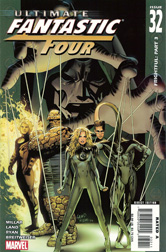 Compared to the stable creative teams of books like Ultimate Spider-Man and The Ultimates, the Ultimate Fantastic Four series has seen a fairly regular shuffling of artists and writers, and this week we see the end of the run for the current team, as well as an outing from the book’s next writer.
Compared to the stable creative teams of books like Ultimate Spider-Man and The Ultimates, the Ultimate Fantastic Four series has seen a fairly regular shuffling of artists and writers, and this week we see the end of the run for the current team, as well as an outing from the book’s next writer.
Mark Millar was the co-creator of the Ultimate Fantastic Four, but he didn’t take over the full scripting chores until last year. He hit the ground running, and brought a wild-eyed passion to the title that was reminiscent of Walt Simonson’s memorable run on the regular FF book. Working in short story arcs (2 and 3 issues at a time), he threw out concepts left and right, with time travel, parallel universes, body-switching, and the introduction of the “Marvel Zombies” (that Robert Kirkman then turned into the surprise hit of the year). #32, his final issue, wraps up the confrontation between the FF, their zombie counterparts, The Ultimates, and Dr. Doom, and it’s a blast, with the clock counting down on the threat of a zombie invasion of earth, and Doom’s master plan threatening the FF. It feels a tad rushed, and could probably have done with a few more pages (if not an entire extra issue), but better too much going on than not enough.
Greg Land’s art remains very much a matter of personal taste. While his sequential work continues to improve, his tendency to pose his characters awkwardly with photoshopped famous faces can still stop a story dead in its tracks. There is some very effective work here, though— Dr. Doom in Reed Richards’ body is a chilling characterization, and his work with the zombies makes it looks like he’s trying to one-up Sean Phillips in the grossout department. This won’t be his last go-round with the Ultimate FF, as he’s doing the Ultimate Universe-Squadron Supreme crossover later this year.
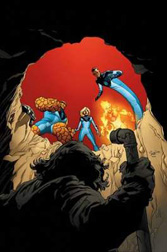 Coming out the same week as this creative team’s farewell, we have the second Ultimate Fantastic Four Annual, written by Millar’s successor, Mike Carey.
Coming out the same week as this creative team’s farewell, we have the second Ultimate Fantastic Four Annual, written by Millar’s successor, Mike Carey.
This isn’t Carey’s first run with these characters: possibly the best story this series has had so far was his introduction of the Ultimate “Mad Thinker”, in issues 19-20. In that case, Carey focused as much attention on the FF’s fascinating adversary as the team itself. That’s a valid way to tell a story, of course, but it works better as change of pace than a steady diet, and his story for this Annual is maybe too much of the same. The Mole Man (in the Ultimate universe, a former teacher of young Reed and the Storms) sinks a group of young N-Zone researchers deep underground, and relates his story to them as he prepares to involve them unwillingly in his plans for a new civilization; meanwhile, the FF come after them. Carey’s Mole Man’s a great character, and there’s some real wit in the dialogue, but unfortunately, little of it involves the title characters.
Artist Stuart Immonen was the first regular penciller on this series, though for this go-round, he’s stripped things down to something quite similar to his work on Nextwave (the female characters all look like a variation on Boom Boom or Elsa). The segments on the Mole Man’s history are handled by Frazer Irving, and they’re excellent: dark here, delicate there. The climax pits the FF against a nice assortment of the Mole Man’s monsters, but at this point in the story, they feel like an afterthought. Carey provides a twist that’s not entirely unexpected, and I’m guessing the FF will meet these young scientists again. In the end, it’s a good story, but maybe not such a great Fantastic Four story.
I’m not sure what this book portends for Carey’s run on Ultimate Fantastic Four. This title’s regular shifting of writers has, in my opinion, kept these characters from completely finding their voices, and unless Carey’s prepared to settle in and focus his attention on the members of the FF, all these fanciful backstories and the promised “cosmic” direction of the book won’t add up to much, compared to Millar’s fast-paced craziness.
Ultimate Fantastic Four #32: RATING: 
Ultimate Fantastic Four Annual #2: RATING: 
Slap yourself on the head, Phonogram presents the obvious merging of mysticism and music
By Graig Kent
 Sure, cheesy hair metal band videos in the 80’s would show how the power of their sounds could conjure up scantily clad ladies in an effort to disguise their own latent homosexuality, but that’s not the kind of magic music makes in Phonogram, a new 6-issue mini-series from Image. Instead, the book coins the term “phonomancer”, or one whose powers derive from their attunement to the music they listen to, and introduces us to David Kohl, a mid-level ‘mancer and also a Type A a-hole.
Sure, cheesy hair metal band videos in the 80’s would show how the power of their sounds could conjure up scantily clad ladies in an effort to disguise their own latent homosexuality, but that’s not the kind of magic music makes in Phonogram, a new 6-issue mini-series from Image. Instead, the book coins the term “phonomancer”, or one whose powers derive from their attunement to the music they listen to, and introduces us to David Kohl, a mid-level ‘mancer and also a Type A a-hole.
David is our guide into this sub-culture that reaches beyond hipsters and scenesters, and into darker and deeper territory. First stop is Ladyfest, an honest-to-god actual festival (this year’s UK Ladyfest is being held in Newcastle) for, obviously, female performers. David is a rogue of the Warren Ellis/Garth Ennis ilk, a cocky British bastard who you only start to like when he gets taken down a notch or two, and his purpose at Ladyfest is not so much to enjoy the sounds but to score himself a lady with his magical understanding of music. After one successful night, he finds himself in a precarious situation when a Goddess finds him out, and his only salvation from her wrath is to become her servant. Ooops.
Steeped highly in the lore of 1990’s Brit-pop (the covers for the series will all be cops from popular album covers, this issue is a fine replica of Elastica’s eponymous release), it doesn’t hurt too much if you don’t know all the references that are being made, but if you want the full skinny there’s a glossary in the back that helps. Though steeped in a timeframe and alternative world of music, the book doesn’t feel elitist any more than, say, the first issue of Fables or Hellblazer, it just feels equally foreign and intriguingly complex.
In essence, the book is a fantasy for rock journalists – of which writer Kieron Gillen is one – with characters able to derive greater magical powers from a higher understanding of the music they listen to. In itself, it’s equally an analysis of an era of music as it is entertainment. It’s critique surrounded by character and story, and for a novice comic scribe, Gillen has tightly honed abilities. In favourable comparison to Grant Morrison’s work on the Invisibles or Ellis’ work on Transmetropolitan, and even a little of Preacher’s swagger, Gillen’s influences in music and comics are obvious. He’s also fortunate to have found a very talented artist in Jamie McKelvie, who works a super-clean line, and has mastered digital shading (avoiding muddiness and over-rendering). He captures people and clothes, style and attitude like an early Kevin Maguire or Mike McKone, with the slightest hint of an appreciation for anime. A surprising and stellar start to a series that screams Vertigo, but comes from Image.
RATING: 
Wonder Woman: Back and built better than ever
By Devon Sanders
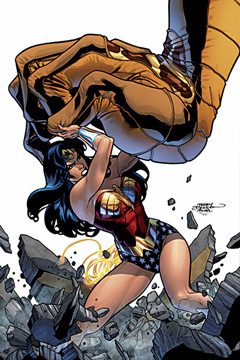
I love the character of Wonder Woman. I know I do. Love is missing something or someone when they’re gone. Love is missing their nearness. I missed Wonder Woman during her DC Comics imposed Infinite Crisis induced hiatus. I fell in love all over again with the character following May’s release of Wonder Woman #1. I was given an unexpected chance to miss Wonder Woman all over again due to an unintended two month gap between issues. Is Wonder Woman #2 worth an extra two month’s wait? All I can offer is a resounding “yes” to both questions.
In the past, Wonder Woman’s enemies do what villains do, attacking Donna Troy, the “new” Wonder Woman along with her teen sidekick, Wonder Girl. What makes this different are the two dark guardian angels watching over them. An identity is forged, a friendship is re-kindled and everything in The DC Universe seems to be just a bit brighter. Fast forward to now as Agent Diana Prince finds herself desperate to save the life of her former sidekick, Donna Troy, after he defeat at hands of The Cheetah, Dr. Psycho and Giganta. Added to the mix are Wonder Girl’s feelings of abandonment after Diana’s unexpected departure. Somewhere, in-between her abandonment issues and the death of her boyfriend, Superboy, she’s become reckless and more than ready to fall into a trap. With the trap set and Donna Troy & Wonder Girl used as the denouement, it’s up to Agent Diana Prince to give the villains the one thing only she can give them: a one, true Wonder Woman. Diana’s glasses come off, a familiar twirl is begun… and stopped. The right man for the job has just arrived.
Writer Allan Heinberg (Young Avengers) once again, with Wonder Woman #2, proves himself highly adept at character development. Every character is given a rich “voice” along with credible motivations to bring the reader money well-spent . Heinberg perfectly fills the readers in on these characters’ histories without once ever weighing the story down while accomplishing the nigh-impossible trick of making back story work for the story he wants to tell.
Artist Terry Dodson artwork is, again, very much worth the wait. Dodson’s page layout has grown by leaps and bounds to the point where anything this reviewer could find wrong would be absolute nit-pickery and quite possibly outright lies. Dodson’s characters with their chiseled features and upturned mouths encompass every aspect of what a superhero should be.
Combining a writer and artist team operating at the top of their games, Wonder Woman #2 is a joy to behold and delays aside, everything this reader looks for in a comic book.
RATING: 
Death to Superheroes! The Boys #1
By Jeb D.
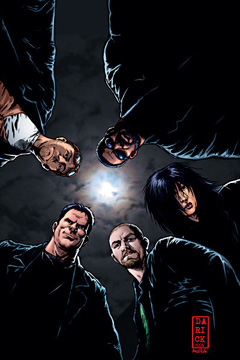 For those of you that may be in a hurry, maybe I can help you out: this is a Garth Ennis comic.
For those of you that may be in a hurry, maybe I can help you out: this is a Garth Ennis comic.
For some, that’s enough to send you to the comic shop sight unseen. For others, it means you can’t skip past this review fast enough. Ennis, let’s face it, can be a very polarizing writer.
The Boys tells a familiar Ennis story: Our protagonist is Billy Butcher, the smug, tough-as-nails one-time leader of a paramilitary team whose job was to take down super-powered characters. In a world becoming overcrowded with super-beings whose hubris and recklessness are endangering civilians, he decides it’s time he was back in business. While we’re getting a quick sketch of his character (you know—sneering insults, knee to the groin, and anal sex with the head of the CIA—that sort of thing), we also meet Hughie (“played” by Simon Pegg), who loses his girlfriend in a bizarre and ugly accident with a superhero, and who may be set up to be the conscience of the series (much like Matt Murdock’s role in Ennis’ The Punisher Kills the Marvel Universe).
It’s the familiar Ennis mixture of sex, snark, and ultraviolence, with plenty of British slang thrown in to dazzle us colonials. You can’t deny the craft involved, even if it seems to be repeating elements he’s used many times before.
Artist Darick Robertson has teamed with Ennis often enough to delineate his world perfectly—it’s appropriately drab and ugly (even the superhero costumes are devoid of much flair). He captures the facial expressions nicely, and Hughie’s grief is completely poignant and real.
As I said up top, this is a Garth Ennis comic. No one else can do what he does, but at times like this, it would be easy to wonder if he can (or, more to the point, is willing to) do anything else. It’s only one issue, of course, but Ennis isn’t much for veering off his path: he might cross us up with something unexpected, but I’m not guessing that’s likely. I’d suggest trade-waiting, but given the sporadic nature of DC’s trade program (Ennis’ brilliant Hitman series has still never been fully collected), that’s a bit iffy.
If you’re hungry for some Ennis to hold you over between issues of The Punisher, this might fit the bill, but a few years down the road, it’s unlikely to be mentioned in the same breath with Preacher.
RATING: 
Nostalgia machine go: Spider-Man Family Featuring Spider-Man’s Amazing Friends
By Graig Kent
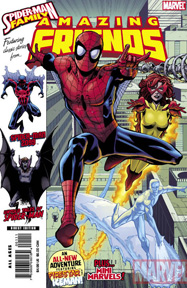 Ah, yes, I do have fond memories of Spider-man and his Amazing Friends, which ran on NBC back in the early 1980’s. Okay, no I don’t. I was six. Who remembers anything from when they were six except seven-year-olds? But the title alone conjures a sense of happiness and familiarity, thoughts of Spidey, the X-Men’s Iceman and new character Firestar (who later became a New Warrior). Like most shows you left behind in childhood, keeping them as fond memories is probably best, because invariably they’re not going to be anywhere near as entertaining as they were when you were a tot.
Ah, yes, I do have fond memories of Spider-man and his Amazing Friends, which ran on NBC back in the early 1980’s. Okay, no I don’t. I was six. Who remembers anything from when they were six except seven-year-olds? But the title alone conjures a sense of happiness and familiarity, thoughts of Spidey, the X-Men’s Iceman and new character Firestar (who later became a New Warrior). Like most shows you left behind in childhood, keeping them as fond memories is probably best, because invariably they’re not going to be anywhere near as entertaining as they were when you were a tot.
But that doesn’t stop comic book companies from exploiting your need to reclaim your childhood, and thus we have this unseemly tome with the title so horrendous they didn’t even put it on the cover: Spider-Man Family Featuring Spider-Man’s Amazing Friends.
I’m not sure what the concept was behind this book, but it’s complete mess from cover to cover, with two original stories written by Sean McKeever, two reprinted tales from Untold Tales of Spiderman and, puzzlingly, the second issue of Spider-Man 2099(!?). McKeever’s first tale, team drawn by his amazing friends Pat Olliffe, Casey Jones, Kano and Nick Dragotta, features the first team up of Spiderman, Iceman and Firestar. But as fire and ice are opposing forces in nature, so too are they in person. Ol’ Peter Parker, however, sees their firey antagonism and icy demeanours to mean that they have feelings for each other, and sets them up on a date. Relationship foibles ensue. It’s cute and it looks pretty, but it’s as disposable as a twice-used Bic razor.
The second story is a cutesy six-page lil’ Spidey (officially “Mini Marvels”) adventure which may have well just been a Peter Porker: Spider-Ham yarn. Remember how Archie spawned Li’l Archie back in the ‘80’s? This is like that, but with superheroes. Uh huh.
The first “Untold Tale of Spiderman” is a mediocre Stan Lee-esque tale of Spidey taking on a commission to capture the man-bat-esque character named Batwing, only to find out the creature’s horrible origin and become his defender instead. It’s patented melodrama in the style of classic House of Ideas, with Gene Colon-esque linework by Patrick Olliffe, and Kurt Busiek taking care not to do anything too exciting. The second “Untold Tale” is a goofy and almost distasteful 6-page gag by the legendary Fred Hembeck. Not particularly funny but at least more like Archie than Li’l Archie.
Finally, was printing Spider-Man 2099 a good idea the first time around? Is dredging him back up again really necessary. Nothing disparaging to Peter David and Rick Leonardi, they did their best with the concept they were dealt with, but it doesn’t work well at all. I don’t think the 2099 universe is old enough to be retro kitschy yet… wasn’t there a New Universe Spidey they could rehash or something? I guess in the idea of exploiting peoples childhoods for this collection, someone had to grow up reading it… I’m assuming anyway.
The whole book from the title to the last Hembeck page is confusing, with the occasional glimmer of charm or creativity. If you’re looking to give your sweet tooth a buzz, there’s saccharine here, but the beef is still at Wendy’s.
RATING: 
![]()
